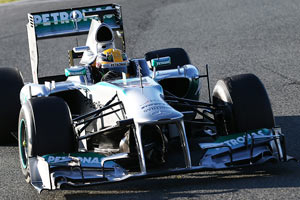kooleracer wrote:I think the fact that lewis pitted and fitted hard tyres with less fuel, has more impact then the temp dropping 2 degrees. Hamilton went from option to option and then went to prime. With less fuel and new tyres any car would feel different. The feeling of new rubber and a lighter car explains resurgence more then 2 degrees drop because it was still hot compared to other races. The strategy for lewis worked perfectly. Doing 2 short stints and 1 long one the harder tyres with less fuel is the perfect strategy. Mediums are quicker so you will lose less time and the hard tyres can go longer en is more durable because during stint 3 Lewis had less fuel onboard.
But maybe during the season Ted Kravtiz or some one can ask Ross.
While you have some nice theories a lot of your logic is flawed.
I don't recall where the MS said they run 15kg heavier than other cars, but if true that will be relative to the LIGHTEST cars (Renault), not others running Mercedes engines (which are confirmed as consuming more fuel for higher power). Also 15kg is NOT 1.5s/lap, it is probably closer to half that on a pure weight basis, but then they have additional power which will offset some of that too.
Having an extra 15kg of fuel is NOT going to have an impact on tyre degradation.
Approximate total vertical tyre force =~(640kg car mass+ 150kg fuel)*9.8 + ~15000N of downforce = 22500 N. An extra 150N is negligible.
Also, it is actually very common to fuel save in races. When a team says that they "under fueled" it doesn't mean that they forgot to put in 20kg of fuel at the start. It was calculate before the race that they would run a certain number of laps in a lower mix mode, but due to unforeseen circumstances (they may have been fighting more with other cars than expected) they may have to severely limit their fuel consumption towards the end of the race. These cars are always crossing the line with the bare minimum of fuel left in their tanks (typically less than 1kg above the FIA sample) unless there is an extended safety car period.
The main problem MAMG have is that they overheat the rear tyres (as they have done for the last couple of years).
This could be due to a large number of reasons:
Lack of rear downforce causing the tyre to slide
Heat from exhaust
Suspension geometry / FRIC
Others (that nobody, even highly experienced engineers in a top Formula 1 team, can think of)
This HELPS them in qualifying where getting the tyres up to temperature in the space of 1 lap is necessary to maximise the grip and therefore speed.
In the race, these temperatures will get high and stay high (going above the temperature-grip peak) resulting in slower lap times, or forcing the drivers to slow down to cool the tyres. A lot of the drivers talk about how they only drive at 80% in the race to save the tyres. Maybe the Merc drivers have to drive at 75% to save the tyres. This would be more likely to account for the difference we see in the laptimes.



